Part of an ongoing series of 29Secrets stories, taking a deep dive into the history of legendary beauty products and iconic fashion and pop culture moments…
By Christopher Turner
Illustration by Michael Hak
Hollywood’s golden era had no shortage of platinum blondes: Jean Harlow, Veronica Lake, Carole Landis, Jayne Mansfield and Grace Kelly…. But one actress’s iconic blonde hair is a perfect reflection of the time, and has transcended that era to become one of the most iconic of any actress of the 20th century.
When you think about Marilyn Monroe, you immediately imagine the actress’s signature look: bleach blonde hair, red pouty lips and full black lashes. That’s the persona that the former Norma Jeane carefully created through her movies, photo shoots and life in the public eye. But her look – especially her hair colour – was far from natural and took years to achieve.
Early life
Monroe was born Norma Jeane Mortenson at the Los Angeles County Hospital on June 1, 1926. Throughout her young life Norma Jeane would use various surnames interchangeably: Baker (for her mother Gladys’s first husband), Mortenson (for Gladys’s second husband) and Monroe (Gladys’s maiden name).
Gladys was unsure of her daughter’s paternity, and today most Marilyn Monroe biographers agree that Gladys had no idea who the father was. The most frequently told story is that Gladys had an affair with her boss, C. Stanley Gifford, at the film lab where she worked, and that he broke things off once he found out she was expecting. (Gifford notoriously refused contact with Marilyn in later years, even after she became famous.)
In 1934, Gladys had what was then described as a nervous breakdown, and was institutionalized after being diagnosed with paranoid schizophrenia. She spent the rest of her life in and out of hospitals, and was rarely in contact with her daughter, who ended up spending her troubled childhood in at least one orphanage and being shuffled between a series of 12 foster homes (where she endured sexual assault on several occasions and was raped at age 11). When she wasn’t living in a foster home, Norma Jeane lived with relatives or in the various homes of her mother’s friend, Grace McKee (later Goddard), who eventually became her guardian and took responsibility for her and her mother’s affairs.This situation became more complicated when Grace remarried.
Even when Grace couldn’t house Norma Jeane herself, she remained very involved in her life. When Norma Jeane would return to the foster system, Grace would visit her often, bringing new dresses and makeup to keep up the often-abandoned girl’s spirits. In fact, it was Grace who planted the dream of Hollywood stardom in Norma Jeane. Grace was captivated by Hollywood’s original blonde bombshell, Jean Harlow, and that obsession formed the basis for Norma Jeane’s fascination with the cinema and Hollywood’s glamorous actresses.
At age 16, the fresh-faced brunette Norma Jeane was back living with Grace when she was faced with another return to the foster system. Instead, she dropped out of high school and opted to marry 21-year-old James Dougherty on June 19, 1942, just weeks after her 16th birthday. A year later, in 1943, he joined the US Merchant Marine, and she took a job at an airline plant in Burbank as part of the World War II factory effort, working first as a parachute inspector and later as a paint sprayer.
Modelling days
In late 1944, Norma Jeane met photographer David Conover, who had been sent by the US Army Air Forces’ First Motion Picture Unit to the factory where she was working to shoot morale-boosting pictures of the women working in the plant. Conover was immediately taken with the pretty brunette and snapped a few colour photos of her working on the line.
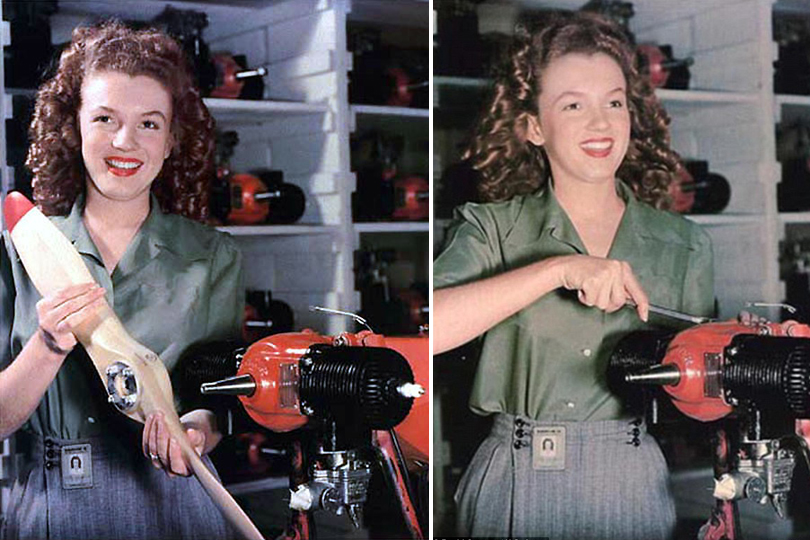
As Conover later wrote: “I moved down the assembly line, taking shots of the most attractive employees. None was especially out of the ordinary. I came to a pretty girl putting on propellers and raised the camera to my eye. She had curly ash blonde hair and her face was smudged with dirt. I snapped her picture and walked on. Then I stopped, stunned. She was beautiful. Half child, half woman, her eyes held something that touched and intrigued me.”
Norma Jeane was flattered. No one had ever singled her out for a good reason. After that day Conover wanted to shoot her again and again, and so did his photographer friends. On each shoot she’d pester the photographer with questions about lenses and lighting, and what she could do with her poses and makeup to make each image perfect. In no time, Norma Jeane defied her deployed husband, moved out on her own, and in January 1945 quit working at the factory. By August 1945, she had signed a contract as a photographer’s model with the Blue Book Model Agency.
Ironically – considering what she came to represent in terms of artificial, unattainable beauty – in 1945 the future Marilyn Monroe was coveted by photographers for her natural look.
When Jim Dougherty returned in December 1945, after 18 months away, he didn’t recognize his wife. In the spring of 1946, she divorced Dougherty and was ready to throw herself into her work.
Becoming blonde
Soon enough, Emmeline Snively, the head of the Blue Book Model Agency, told Norma Jeane that if she wanted to work more, she would have to bleach her hair. After all, according to Snively, brunettes could only be photographed a limited number of ways, while a blonde could be anything.
“Look, darling,” Snively later recalled telling her, “if you really intend to go places in this business, you’ve just got to bleach and straighten your hair, because now your face is a little too round and a hair job will lengthen it.”
One afternoon in 1946, Snively sent Norma Jeane to Frank & Joseph’s Beauty Salon, which was across the street from the Blue Book Agency. The renowned stylists were responsible for the hair of such Hollywood notables as Rita Hayworth and Ingrid Bergman. Tint technician Sylvia Barnhart immediately set out to straighten Norma Jeane’s hair, which Barnhart has described as “brown and kinky.”
The strong solution used in the process also lightened her hair, giving it a reddish-blonde cast. Norma Jeane was quite pleased by the effect (she thought it brought out her eyes) and wanted to go even blonder, to be more like her idol Jean Harlow. So over the next few months, Barnhart slowly changed the colour of Norma Jeane’s hair to a golden honey-blonde by lightening and toning it one step at a time.
She also underwent electrolysis around her hairline to remove her widow’s peak.
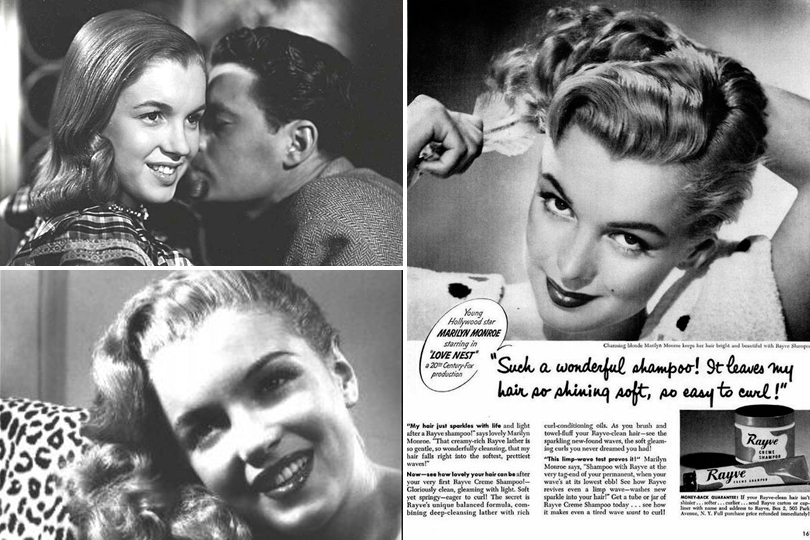
Like Harlow, Norma Jeane’s blonding hair caught Hollywood’s most prolific eye, Howard Hughes. In the mid-’40s, Hughes (the head of RKO) spotted one of the 33 magazines that had published pictures of Norma Jeane, and requested that she be found and brought in for a screen test. Norma Jeane’s agency used Hughes’ interest as leverage to get their client a meeting with Ben Lyon, casting director at 20th Century Fox, and Norma Jeane was quickly tested with cinematographer Leon Shamroy.
When Shamroy got the film back from the session, he was stunned. He would later say that the camera captured something in this newly blonde woman that he hadn’t seen in years – surely not since Hollywood’s original blonde bombshell, Jean Harlow. Shamroy notably described her as “sex on a piece of film.”
On August 26, 1946, Norma Jeane was signed to a one-year, $125/month contract with 20th Century Fox, on the condition that she find herself a new name. Lyon suggested that she take the name Marilyn, and she added her mother’s maiden name (the only name she was sure she could accurately embrace as her own), Monroe.
As the shy, timid Norma Jeane transformed into the more glamorous Marilyn Monroe, her hair continued to change. Barnhart continued to straighten and bleach her hair for years to come, and when Barnhart moved to Frank & Joseph’s other salon on Hollywood Boulevard, Marilyn followed her.
For several years afterwards, Marilyn kept a weekly appointment with Barnhart on Saturdays at 1:30 pm. “She’d come in like two or three hours late and still expect to be taken care of,” Barnhart recalled. “But she was just magnificent, breathtaking to look at.”
Ironically, Barnhart would play another key role in Monroe’s life. Years after their first meeting, Barnhart inspired Pola, Monroe’s character in How To Marry A Millionaire (1953). Monroe recalled watching Barnhart without her glasses bumping into furniture, and incorporated the glasses and klutziness into her iconic role.
Stardom beckons
Stardom wasn’t instant for Monroe – changing her hair colour did help set the wheels in motion, but she didn’t truly become a star for another few years. There were the short-lived film contracts with 20th Century Fox and Columbia Pictures, and a series of minor film roles. There were also more modelling gigs, plastic surgery, a string of failed relationships, and acting classes. She signed a new contract with Fox in late 1950 and finally began to break through, securing roles in several comedies, including As Young as You Feel (1951) and Monkey Business (1952), and in the dramas Clash by Night (1952) and Don’t Bother to Knock (1952).
Then Monroe found herself at the centre of a scandal in March 1952, when news broke of the publication of an upcoming pinup calendar. Golden Dreams claimed to feature nude pictures of Monroe shot by pinup photographer Tom Kelley. Uneasy studio execs begged her to deny the story to avoid damaging her budding career, but Monroe took matters into her own hands and went rogue during an interview. She cried to the journalist that it really was her in the pictures! She stressed she had been cash-strapped and jobless back in 1949 and had posed for Kelley (whose wife was also in the room) because she needed the $50 to make a car payment.That turned out to be a move that only increased her star power. The story, which she knew the journalist would lead with, didn’t damage her career…instead; it generated sympathy and resulted in increased interest in her films.
Pillow-case white
Eventually Marilyn’s hair was completely stripped of pigment and her hair lightened to a dazzling platinum blonde – or, in her own words, “pillow-case white.”
Barnhart may have been the stylist who turned Monroe into a blonde, but she wasn’t the only stylist in Monroe’s life. Years later, when Monroe was a bona fide star, she would work with a rotating team of hairstylists like Kenneth Battelle, Gladys Rasmussen and Pearl Porterfield – the Hollywood hairdresser responsible for Jean Harlow’s own pale blonde locks. For the remainder of Monroe’s life, according to author Pamela Keogh, her stylists applied peroxide and bleach highlights every three weeks.
“There are several problems with doing Marilyn’s hair; it’s very fine and therefore hard to manage,” Rasmussen once said in an interview. “The way we [get] her shade of platinum is with my own secret blend of Sparkling Silver bleach plus 20 volume peroxide and a secret formula of silver platinum rinse to take the yellow out.”
Monroe was said to have minimized washes and hidden her dark regrowth by dabbing sifted Johnson’s Baby Powder (the OG dry shampoo) on her roots.
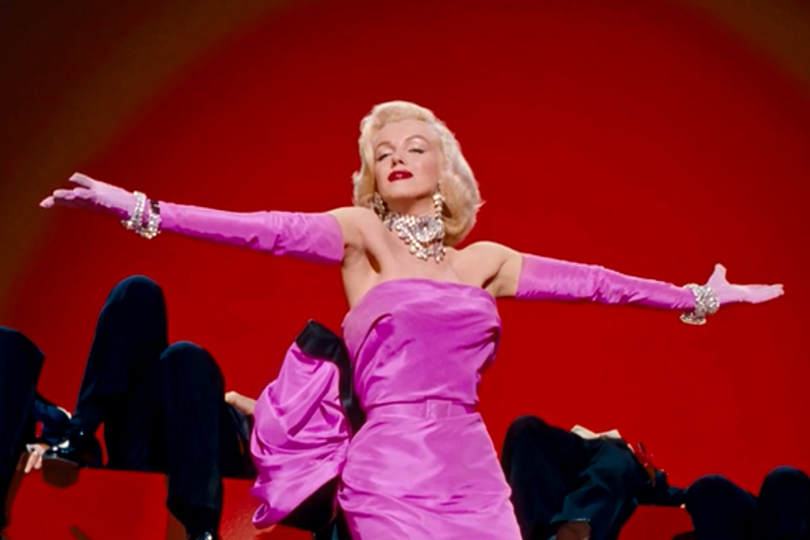
Monroe and her pillow-case white blonde hair dominated Hollywood. With performances in Gentlemen Prefer Blondes (1953), How to Marry a Millionaire (1953) and There’s No Business Like Show Business (1954), she became the object of unprecedented popular adulation around the world. In 1954 she married baseball star Joe DiMaggio, and while the marriage lasted less than a year, the publicity was enormous. In 1956 she married playwright Arthur Miller. By the end of the decade she won critical acclaim (for the first time) as a serious actress for Some Like It Hot (1959). Her last role, in The Misfits (1961), was written by Miller, whom she had divorced the year before.
In 1962 Monroe began filming the comedy Something’s Got to Give, but was fired in June because she was frequently absent from the set because of illnesses. Of course, that was after she travelled to New York City in May to attend a gala where she famously sang “Happy Birthday” to President John F. Kennedy, with whom she was allegedly having an affair.
After several months as a virtual recluse, Monroe died from an overdose of sleeping pills in her Los Angeles home on August 5, 1962. Her death was ruled a “probable suicide,” though conspiracy theories continue to persist to this day.
The last word
Today Marilyn Monroe remains the definitive platinum siren of Hollywood’s golden era; herbiography is a collage of stories, some true and some creative concoctions of her blonde bombshell persona created by Hollywood studios. But, ultimately, Monroe had the final word on her infamous hair. In her posthumous autobiography titled My Story (which was released 12 years after her death), she wrote: “In Hollywood a girl’s virtue is much less important than her hair-do. You’re judged by how you look, not by what you are. Hollywood’s a place where they’ll pay you a thousand dollars for a kiss, and fifty cents for your soul. I know, because I turned down the first offer often enough and held out for the fifty cents.”
![]()
Want more? You can read other stories from our The Story Of series right here.

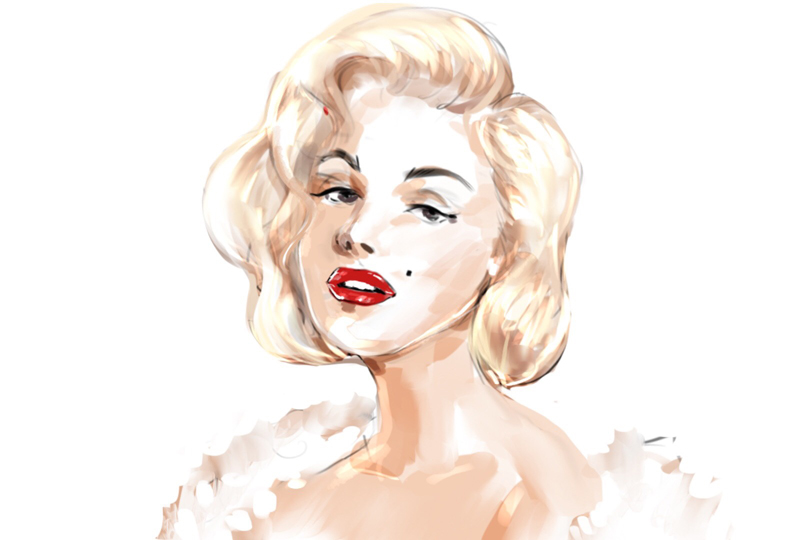


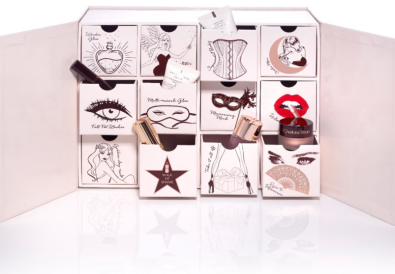
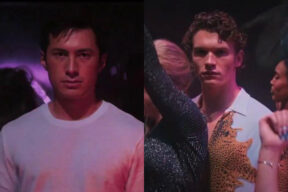







Absolutely awesome article. Thanks Mr. Turner.